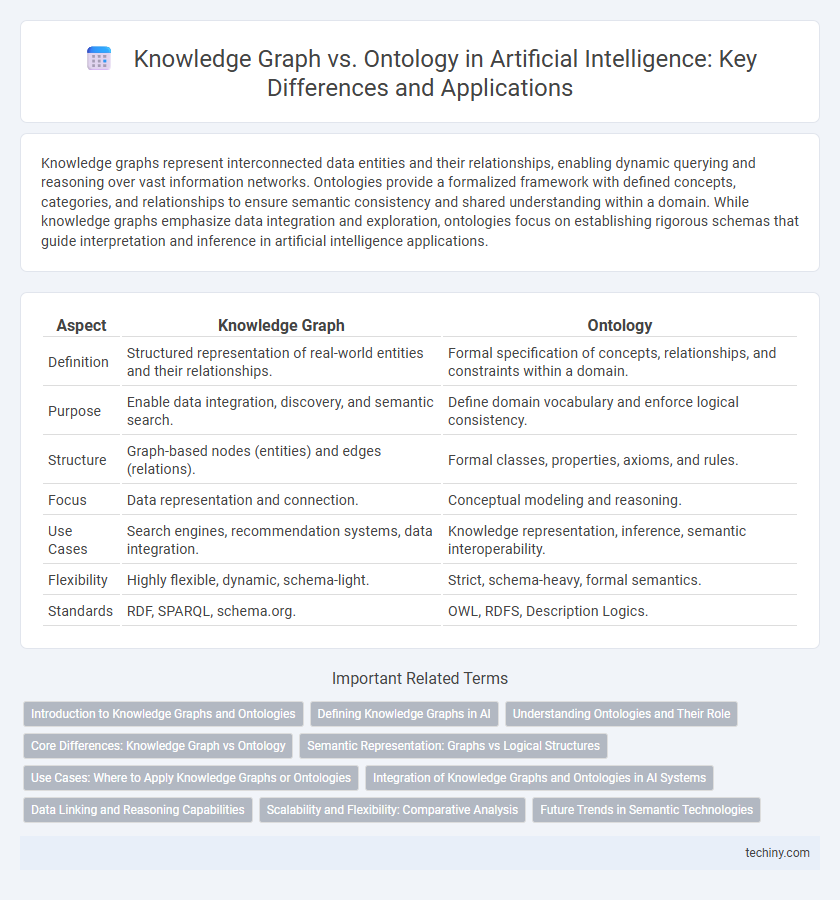Knowledge graphs represent interconnected data entities and their relationships, enabling dynamic querying and reasoning over vast information networks. Ontologies provide a formalized framework with defined concepts, categories, and relationships to ensure semantic consistency and shared understanding within a domain. While knowledge graphs emphasize data integration and exploration, ontologies focus on establishing rigorous schemas that guide interpretation and inference in artificial intelligence applications.
Table of Comparison
| Aspect | Knowledge Graph | Ontology |
|---|---|---|
| Definition | Structured representation of real-world entities and their relationships. | Formal specification of concepts, relationships, and constraints within a domain. |
| Purpose | Enable data integration, discovery, and semantic search. | Define domain vocabulary and enforce logical consistency. |
| Structure | Graph-based nodes (entities) and edges (relations). | Formal classes, properties, axioms, and rules. |
| Focus | Data representation and connection. | Conceptual modeling and reasoning. |
| Use Cases | Search engines, recommendation systems, data integration. | Knowledge representation, inference, semantic interoperability. |
| Flexibility | Highly flexible, dynamic, schema-light. | Strict, schema-heavy, formal semantics. |
| Standards | RDF, SPARQL, schema.org. | OWL, RDFS, Description Logics. |
Introduction to Knowledge Graphs and Ontologies
Knowledge graphs represent interconnected entities and relationships in a graph structure, enabling data integration and retrieval across diverse sources. Ontologies define formal vocabularies and hierarchical relationships within a domain, providing a semantic framework for knowledge representation and reasoning. Both knowledge graphs and ontologies enhance artificial intelligence applications by structuring complex information for more accurate data interpretation and decision making.
Defining Knowledge Graphs in AI
Knowledge graphs in AI represent structured frameworks that integrate diverse data sources into interconnected nodes and relationships, enabling machines to understand real-world entities and their attributes more effectively. Unlike traditional databases, knowledge graphs utilize semantic relationships to facilitate advanced reasoning, context-aware search, and enhanced decision-making processes. Their dynamic nature supports continuous learning and adaptation, which is critical for evolving AI applications in natural language processing and recommendation systems.
Understanding Ontologies and Their Role
Ontologies provide a structured framework for representing knowledge within a domain by defining concepts, relationships, and constraints, enabling machines to interpret and reason about data accurately. Knowledge graphs leverage ontologies to integrate heterogeneous information, facilitating semantic search and advanced AI applications through interconnected entities and their attributes. Understanding ontologies is crucial for building effective knowledge graphs that support intelligent data retrieval, reasoning, and decision-making processes in artificial intelligence.
Core Differences: Knowledge Graph vs Ontology
Knowledge graphs represent relationships between entities as interconnected nodes and edges, enabling dynamic and scalable data integration from various sources. Ontologies define formal, structured vocabularies with explicit rules and constraints to standardize the classification and relationships of concepts within a specific domain. While knowledge graphs emphasize flexible, real-world data linking, ontologies focus on formal semantic modeling and reasoning.
Semantic Representation: Graphs vs Logical Structures
Knowledge graphs represent semantic relationships using nodes and edges, enabling intuitive visualization and flexible data integration across diverse domains. Ontologies employ formal logical structures with defined classes, properties, and axioms to facilitate rigorous reasoning and inferencing in artificial intelligence systems. The distinction lies in knowledge graphs optimizing graph-based connectivity for dynamic querying, while ontologies emphasize structured, logic-driven semantic precision.
Use Cases: Where to Apply Knowledge Graphs or Ontologies
Knowledge graphs excel in integrating diverse data sources to power search engines, recommendation systems, and complex data analytics by representing relationships and entities in a flexible graph structure. Ontologies are crucial in domains requiring precise, formalized knowledge representation and reasoning, such as healthcare for clinical decision support and semantic data interoperability. Deploying knowledge graphs benefits scenarios focused on dynamic data integration and exploration, whereas ontologies serve best in environments demanding strict logical consistency and standardized vocabularies.
Integration of Knowledge Graphs and Ontologies in AI Systems
Integrating knowledge graphs and ontologies in AI systems enhances semantic reasoning by combining structured data representation with domain-specific hierarchical relationships. Knowledge graphs provide dynamic, interconnected data models while ontologies offer formalized schemas that define concepts and their properties, enabling more accurate inference and knowledge extraction. This synergy improves AI-driven applications such as natural language understanding, recommendation engines, and decision support systems by promoting interoperability and enriching contextual awareness.
Data Linking and Reasoning Capabilities
Knowledge graphs excel in data linking by integrating diverse data sources into a unified, interconnected network of entities and relationships, enabling scalable and dynamic information retrieval. Ontologies provide structured, formal representations of domain knowledge with defined classes, properties, and axioms, supporting advanced reasoning capabilities such as consistency checking and inferencing. While knowledge graphs facilitate flexible data linking and exploration, ontologies underpin semantic reasoning by offering explicit constraints and logical foundations.
Scalability and Flexibility: Comparative Analysis
Knowledge graphs offer superior scalability by efficiently integrating vast and heterogeneous data sources, enabling dynamic expansion without compromising performance. Ontologies provide high flexibility in defining complex domain-specific relationships using formal logic, but often face challenges scaling beyond controlled environments. Combining knowledge graphs with ontologies can leverage the scalability of graph structures and the expressive power of ontological frameworks for advanced AI applications.
Future Trends in Semantic Technologies
Knowledge graphs are evolving to integrate dynamic, real-time data sources, enhancing contextual understanding and decision-making capabilities in AI systems. Ontologies are advancing with improved expressiveness and interoperability standards, enabling more precise semantic reasoning and automated knowledge extraction. Future trends emphasize the convergence of knowledge graphs and ontologies to create robust, scalable semantic technologies that support intelligent applications across diverse domains.
Knowledge Graph vs Ontology Infographic

 techiny.com
techiny.com